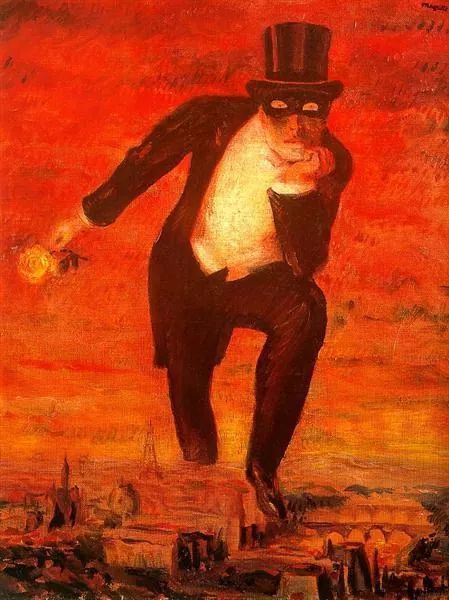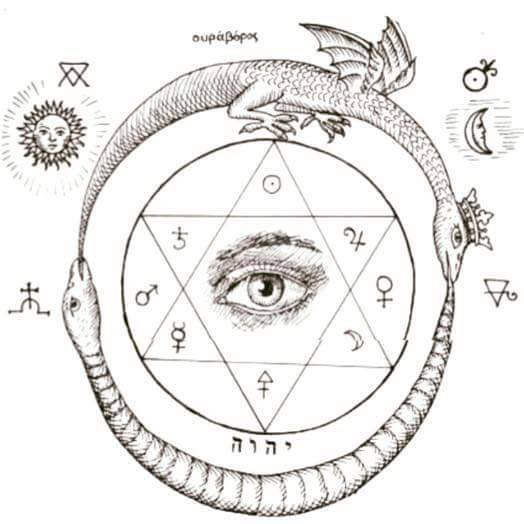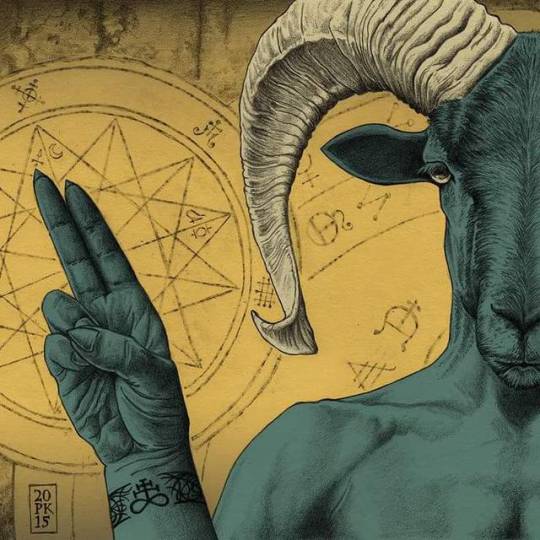Photo

“Every individual has some qualities that endear him to some other. And per contra, I doubt if there is any class which is not detestable to some other class. Artists, police, the clergy, “reds,” foxhunters, Freemasons, Jews, “heaven-born,” women’s clubwomen (especially in U.S.A.), “Methodys,” golfers, dog-lovers; you can’t find one body without its “natural” enemies. It’s right, what’s worse; every class, as a class, is almost sure to have more defects than qualities. As soon as you put men together, they somehow sink, corporatively, below the level of the worst of the individuals composing it. Collect scholars on a club committee, or men of science on a jury; all their virtues vanish, and their vices pop out, reinforced by the self-confidence which the power of numbers is bound to bestow.” Aliester Crowley
2 notes
·
View notes
Photo

The History and Evolution of "Pannism" from ancient mythology around 150 BCE, saw the decline of the Pan cult which started to tame or go underground. During the Dark Ages (around 500 to 1000 CE), Europe convulsed with the invasions of "barbarians" from the outside, like the Goths, as well as the resurgence of "pagans" from the inside, like the Celts. Finally, as Christianity prevailed over the whole continent, all public practice of pagan rites ended. Still, invaders and others brought their own religions with them. Interestingly, most of these religions had their own horned gods, like Cernnunos, Asmodeus, Herne the Hunter, Tammuz and Damuzi, "The Green Man." Even the Muslims brought in their own version of the devil, Shaitan. These pagan or non-Christian figures had so much in common that eventually "Pannism" matured, evolved and soon became pan-European. Religious rites dedicated to such gods were common, though underground, throughout Europe during the Middle Ages, for example, among the Gypsies. Strong historical evidence suggests that large numbers of them did convert to different religions, though this accusation is still controversial. Much scholarship also points to the evolution and maturing, by around 1150, of goat-god or Pan worship into a more universal god and system of beliefs. This "new paganism" of that time spread throughout Europe but obviously remained secret and underground. Beliefs and worship in this version of the old deities represented to its devotees humankind's vital link to nature and natural impulses. Followers came up with a new name for this version of the old Pan-like gods. In whispered tones, they called him Baphomet. Footnote | Interestingly (enough), Baphomet was derived from the phrase, TEM OHP AB (Temple omnium hominum pads abba), which is simply Latin for “father of the temple, universal peace of men.” TEM OHP AB spelled backwards is where we get the word “Baphomet.” HAIL TEM OHP AB Ye Olde Devil by Kaek
3 notes
·
View notes
Photo

"The whole universe is sum up in the Human Being. Devil is not a monster waiting to trap us, He is a voice inside. Look for Your Devil in Yourself, not in the Others. Don't forget that the one who knows his Devil, knows his God." - Shams Tabrizi
7 notes
·
View notes
Photo

“If you're going to try, go all the way. Otherwise, don't even start. This could mean losing girlfriends, wives, relatives and maybe even your mind. It could mean not eating for three or four days. It could mean freezing on a park bench. It could mean jail. It could mean derision. It could mean mockery--isolation. Isolation is the gift. All the others are a test of your endurance, of how much you really want to do it. And, you'll do it, despite rejection and the worst odds. And it will be better than anything else you can imagine. If you're going to try, go all the way. There is no other feeling like that. You will be alone with the gods, and the nights will flame with fire. You will ride life straight to perfect laughter. It's the only good fight there is.” ~ Charles Bukowski
0 notes
Photo

“The man who speaks with primordial images speaks with a thousand tongues.” — Carl Jung
2 notes
·
View notes
Photo

"With thy right eye create all for thyself; with the left, accept all that be created otherwise." -Book of Thoth
1 note
·
View note
Photo

"There's something that can only be understood within the left handed path... I no longer fear the darksome night; no longer do I question things that try to intimate and cause me fright. Why? For once I was submerged in the darkness, I became the darkness. By doing so, I became protected, by the one thing that could destroy me." Jayson Yuchá
0 notes
Photo

Daemonolatry Basics
Daemonolatry is a practice in which the Daemons are Gods - honoured and respected and worked with as any other god from any other pantheon. They are not cowering lowly creatures from some fiery chasm slithering through our nightmares to create peril and mischief, but They are Divine Beings. Daemons are, in short, the rejected gods of antiquity - villainized and unfairly feared, (the perpetuation of false myths and stigma).
Though the Nature of Daemons is subjective and the opinions as to what They “are” vary from Daemonolator to Daemonolator, most agree that they are all a race of beings belonging to a single energy source - “The All” or “God”, if you will. Much like the Principle of Mentalism - Daemons are often regarded as manifestations of a single source of life force.
This does not mean that the Daemons are not individual beings with individual motivations and personalities, but that They, like us and every creature on earth, are interconnected by the infinite flow of Spirit in and about all things. Daemonolators believe that the spirit of Man is just as elated and lofty as the spirit of any God, Daemon or otherwise - as we are all interconnected and we are all Spirit.
Demonolators almost unanimously believe that the Daemons are our guides and our mentors, our guardians and our protectors. This is not to say that Daemonolators naively believe that Daemons are wholly benevolent - but that They are no more “wicked” than any other god from any other pantheon.
Daemonolators commonly believe that the Daemons gain benefit from the exchange of energy between Themselves and us and that the honouring of Daemons is empowering to Them and (sometimes) crucial for Their prosperity and sustenance. However, most agree that the Daemons do not “need” us to survive, but our honouring of them benefits Them just as much as it does us. Daemonolators believe that one’s perception of Demons and how one approaches and regards Daemons attracts the behavior from Them which most accurately reflects what is projected.
In short, if you fear Daemons and treat Them with disdain, suspicion or disgust, They will not likely treat you with very much dignity, either - just as most any being would not.
Patron Daemons and Mentor Daemons
The fundamental part of Daemonolatry, as mentioned briefly in the previous post, involves each Demonolator working with a primary Daemon - this Daemon is called the “Patron” or “counterpart” Daemon. The Patron Daemon can be a Daemon with whom the Daemonolator connects with on a personal level, one that is the complete opposite of his or her personality. The Elemental Daemon, is one whose lessons benefit them the most or a myriad of other deciding factors.
Along with a Patron Daemon, most Daemonolators work with what is known as a Mentor. A Mentor Daemon most always chooses the Daemonolator - not the other way around. In this relationship, the Mentor Daemon seeks to guide the Daemonolator along their path and to teach them life skills and to aid in their earthly pursuits. This is a different relationship from the Patron Daemon in which the Patron aids the Daemonolator in issues pertaining to the Daemonolator as a person (i.e., helping them to better themselves, identify strengths and weaknesses and to overcome obstacles related to personality and fear).
Daemonolators do not solely work with only their Patron/Matron and Mentor Daemons. Daemonolators also work with many Daemons for many different reasons. The Daemonolator’s pantheon is the Daemons.
T.B. Scott, a practising Occultist and Magician, has provided this explanation for Daemonolatry on the site, “Infernal Dialogues”:
NOTEworthy, reading Modern Demonolatry by S. Connolly
2 notes
·
View notes
Text
Hymn to Lucifer
Ware, nor of good nor ill, what aim hath act?
Without its climax, death, what savour hath
Life? an impeccable machine, exact
He paces an inane and pointless path
To glut brute appetites, his sole content
How tedious were he fit to comprehend
Himself! More, this our noble element
Of fire in nature, love in spirit, unkenned
Life hath no spring, no axle, and no end.
His body a bloody-ruby radiant
With noble passion, sun-souled Lucifer
Swept through the dawn colossal, swift aslant
On Eden’s imbecile perimeter.
He blessed nonentity with every curse
And spiced with sorrow the dull soul of sense,
Breathed life into the sterile universe,
With Love and Knowledge drove out innocence
The Key of Joy is disobedience.
by Aleister Crowley
1 note
·
View note
Photo

Astrological Correspondences in Quantum Mechanics The Wave Function lies at the heart of quantum mechanics. It is defined by Schrödinger's Equation and is the description of the quantum state of a system. It is more accurately described as a complex-valued probability amplitude (which means it is based in imaginary numbers and not exactly predictable.) A quantum state described by the wave function actually exists in a state of superposition and non-locality, as well as exhibits mysterious and classically inexplainable phenomenon such as quantum entanglement and quantum tunneling. Although the wave function describes a kind of physical phenomenon, it is open to a wide variety of different interpretations and just like other derived oddities in quantum mechanics, it is mysterious and lacking in real definition. Whether the wave function really exists, and what it represents, are major issues in the interpretation of quantum mechanics. The most common symbol for the wave function is the Greek letter psi Ψ which is very ironic as this symbol is very similar to the astrological symbol for the planet Neptune. I first noticed this while taking notes in courses with quantum mechanics when I kept writing the Neptune symbol instead of psi (I've been doing astrology for many years so it came naturally out of habit.) The only difference between the letter psi Ψ and the symbol for Neptune is the bar that's through the Ψ turning it into the trident of Neptune. At first I thought it was a clearly unconscious mistake on my part and tried to correct it. Yet after numerous failed attempts and continuous repetition of turning Ψ into the Neptune symbol I finally stopped to reflect on it and it was then that I realized how accurate of a description it really was... In astrology, Neptune is the planet of Illusion. Associated with mysticism and magic, Neptune is the ruler of all things ethereal and mysterious, formless and intangible, lacking in definition and boundaries. Neptune is the perfect description of māyā, the Sanskrit word for the illusion of reality, and hence it is the perfect description for the wave function. The Neptune symbol is about the only thing direct and straight-forward about the subject of Neptune. The cross at the lower end of the symbol is symbolic of matter, the root of things - the crux of nature. The cross of matter is the stabilizer amongst the potentially ethereal, mysterious or erratic energies Neptune can represent. The three pronged pitchfork portion on top of the Neptune symbol represents a trident, which was associated with the god Neptune, (Poseidon in Greek) which is the god of the deep, unfathomable waters, the limitless oceans of the collective unconsciousness. Not so commonly known is the trident of the Neptune symbol also represents the threefold essences of nature. Empirically speaking this threefold essence is comprised of: Birth, Life, Death and more generally, Becoming, Being, and Passing away. These Neptunian themes are a strikingly accurate description for the wave function. Another interesting astrological correspondence is found with Planck's constant, also a central figure in quantum mechanics and also found in Schrödinger's equation. The symbol for Planck's constant resembles the symbol for Saturn. Planck's constant can be described as the smallest possible boundary containment on the quantum scale. Planck's constant is a measurement of quantum effects, and it sets limitations to our knowledge of reality on the quantum level. In astrology, Saturn is the planet of restriction, limitation and boundaries. The Saturn symbol is composed of two elements. The top cross which as already discussed is symbolic of the culmination of matter. The second component of the Saturn icon is a lunar crescent, an element which signifies receptivity as well as having associations to the astral plane and the waters. The moon is in fact a lower octave of Neptune. The cross above the crescent represents matter dominating the ethereal, astral waters, representing the Saturnian themes of limitation and restriction. It represents material dominance over the astral, ethereal or spiritual. This lower "crescent" portion of the Saturn symbol is also reminiscent of a scythe or sickle. This is of particular interest because the symbolism of the planet Saturn (and the god Saturn) often addresses themes of death. Note that in the archetype of death, this personification carries the sickle to acknowledge the opportune moment of harvesting life. Although seemingly negative in expression, Saturn is actually a very stabilizing influence. Saturn represents a facilitating energy. Without Saturn, there would be no stability or structure, no discipline, perseverance or hard work. Nothing in the universe could get accomplished, no dreams could be manifested in reality. The symbolism of Saturn is also a perfect representation of the Plancks constant, not only due to its associations with limits, restrictions and constraint, but also because the Plancks constant shows up in all quantum mechanical equations that have anything to do with the materializing effects of quantum phenomenon. Like the stabilizing influences of Saturn, without Planck's constant there would be no quantization of matter, no materializing effects of quantum phenomenon to give structure and stability to reality, solidifying the illusionary māyā and the boundless waters represented by the Neptunian wave function. In short, the fact that the wave function of a quantum mechanical system is described by the symbol for Neptune and the Planck's constant by the symbol for Saturn is an accurate truth and a perfect description in my opinion. After realizing these striking correspondences I finally stopped trying to correct my symbol for the wave function. To this day I still write the Neptune symbol in stead of Ψ and even Saturn for Planck's constant in all my mathematical scribblings in quantum mechanics. - Jessica Jane Poirier Musings of a Mathematical Mind Esoteric Science Institute Occult Physics
0 notes
Photo

Zero is not a natural number. Zero was first used by the ancient Egyptians as a place-holder in their base-10 system, as it is used in ours. The first use of the concept of zero as an actual number can be attributed to ancient India, called “sunya” in Sanskrit meaning “the Void” or “emptiness”. Now what even my Calculus students don’t seem to quite grasp is that zero and infinity are related: they are inverses of each other. One of the first things you learn in grade school math is that you can’t divide a number by zero, it is undefined. But the truth is that when you divide a number by zero you get infinity. And when you divide a number by infinity you get zero. So out of the Void we get the Infinite and out of the Infinite we get the Void. Nothing is truly empty, in fact quite the opposite. Quantum mechanics proves that absolute zero (energy) is impossible. Quantum mechanics also shows how in a vacuum there is an infinite amount of energy!!! That’s right, an infinite amount of energy in empty space. Now all we got to do is learn how to tap into that infinite energy (and I’ll leave that one up to you to figure out…) Also, the first law of thermodynamics (which everyone learns in a basic physical science class) is that energy cannot be created or destroyed, only transferred from one form to another. So energy is the only infinite thing we know of. - Jessica Jane Poirier “The Tao is like a well: used but never used up. It is like the eternal void: filled with infinite possibilities.” (The Tao Te Ching)
1 note
·
View note
Photo

To increase the magick you work with master the use of the elements, learning to balance them in your life and the world around you. - Jasmeine Moonsong
0 notes
Photo

There is a thinking in primordial images, in symbols which are older than the historical man, which are inborn in him from the earliest times, eternally living, outlasting all generations, still make up the groundwork of the human psyche. It is only possible to live the fullest life when we are in harmony with these symbols; wisdom is a return to them. C.G. Jung
0 notes
Text
All of me is beautiful and valuable, even the ugly, stupid and disgusting parts.
0 notes
Photo

Leila Waddell (1880 – 1932) Aleister Crowley’s most infamous muse, and a powerful historical figure in magick and Thelema in her own right. Primary inspiration for “The Book of Lies” (1912) - a book of cryptic occult ritual.
0 notes
Photo

"Your children are not your children. They are the sons and daughters of Life's longing for itself. They come through you but not from you, and though they are with you, yet they belong not to you. You may give them your love, but not your thoughts. For they have their own thoughts. You may house their bodies but not their souls, for their souls dwell in the house of tomorrow, which you cannot visit, not even in your dreams. You may strive to be like them, but seek not to make them like you. For life goes not backward, nor tarries with yesterday." ~ Khalil Gibran
1 note
·
View note
